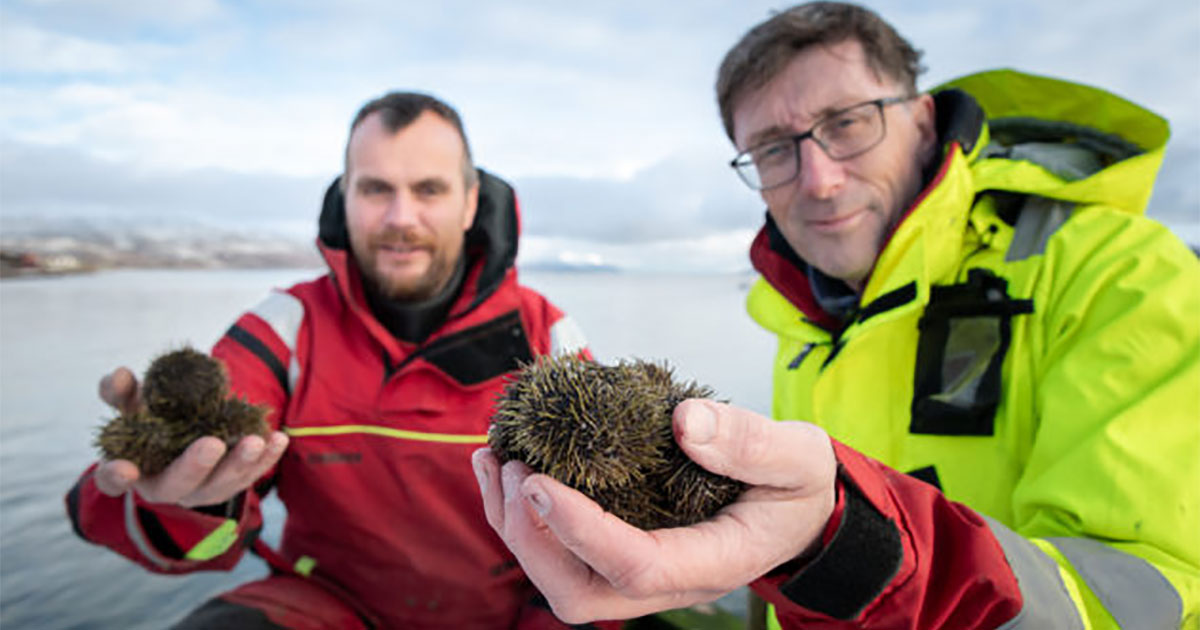Sea urchins on the seabed eat a lot of kelp and cause great damage to the kelp forests along the Norwegian coast.
“Sea urchins have decimated kelp forests along the Norwegian coast for a long time. Once established, they can remain for decades,” says Nofima Senior Scientist Philip James.
However, there is hope for the seabed—kelp forests will grow back if sea urchins are removed. In addition, sea urchins can create a new industry in Norway.
Regenerative Aquaculture
To regenerate means to help something regrow that has been damaged. Utilizing sea urchins retrieved from destroyed kelp forests can be considered regenerative aquaculture, since kelp forests grow back when the sea urchins are removed. After the sea urchins have been retrieved from the seabed, they are enhanced to improve the size and quality of the roe in land-based facilities. Nofima has been working on this for more than 20 years.
“After just a few weeks of feeding, the size and quality of the sea urchins’ roe increases, and so does the market value of the product,” says James.
Sea urchin roe is highly sought after in many countries, and this leads to a very high price per kilogram for the roe. Sea urchin farming in Norway can therefore contribute to high value creation. In addition, many believe that Norway needs to diversify its aquaculture so it doesn’t just rely on salmon farming, and also tackles climate change through low trophic aquaculture.
Major EU Investment in Low-Trophic Species
Since 2019, James has led the EU-funded AquaVitae project. This is a major project on the farming of low-trophic species. Low-trophic species are groups of plants or animals that belong to the lower levels on the food chain, such as macroalgae, oysters, sea cucumbers and sea urchins.
“It has been very rewarding to lead such a major project with partners from different fields and countries. The project has contributed a lot to the development of low-trophic aquaculture in the Atlantic region,” says James.
Low-trophic species could be part of the sustainable food of the future, as researchers in the AquaVitae project have found that farming low-trophic species has a significantly lower carbon footprint than most other types of food production, including red meat, chicken and fish. Production of low-trophic species can even offset some of the carbon footprint from other food production. Part of the AquaVitae project has been dedicated to studying the potential of farming sea urchins sourced in the wild.
Continuation of the Project
James has received funding from the Regional Research Fund in Troms and Finnmark to further study sea urchin potential in regenerative aquaculture. In this project, which starts in January 2024, Nofima is collaborating with stakeholders such as Tarevoktere, a voluntary organization that removes sea urchins to restore kelp forests. Volunteer groups of Tarevoktere divers collect sea urchins and investigate how effectively kelp forests grow back after the sea urchins have been removed. The collected sea urchins can be used in aquaculture, and to further develop other uses of the sea urchin biomass. Not all sea urchins are suitable for farming, so the project will test what these sea urchins can be used for.
“Previous projects have shown that dried and powdered sea urchin can be used as a fertilizer. This is something the project will focus on, as well as developing methods for catching, harvesting and transporting sea urchins, and further developing the farming method,” says James.



